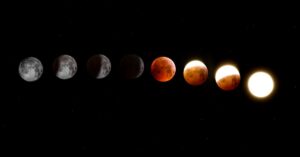This site contains affiliate links to products. I may receive a commission for purchases made through these links.
Stargazing isn’t just for adults. In fact, it’s a fantastic way for preschoolers to learn about the universe. With the right activities, a telescope can become a portal to a world of stars, planets, and galaxies, sparking curiosity and a lifelong love for astronomy.
I’ve spent years exploring the best ways to introduce little ones to the wonders of the cosmos. And I can tell you, there’s nothing quite like their wide-eyed amazement when they see the moon’s craters or Jupiter’s stripes for the first time.
Benefits of Telescope Activities for Preschoolers
Soaking in the wonders of the cosmos they see through a telescope, preschoolers are filled with curiosity and awe. Not only are these moments of pure amazement, but they’re also ripe with a wealth of learning opportunities.
Telescope activities stimulate young minds in unique ways. They present the universe as a grand, uncharted territory full of endless discoveries waiting to be made. What could be more enticing for an active preschooler’s mind?
Mental Stimulation and Cognitive Development
Watching constellations, planets, or far-off galaxies helps preschoolers start to grasp the concept of space and distance at an early age. It’s not just about the visuals; through their questions and observations, they begin to process complex ideas. This exposure to large-scale concepts contributes to cognitive development by strengthening their deductive reasoning and critical thinking skills.
Inspirational and Motivating
As they connect the dots of stars to form constellations, an activity that symbolizes connecting bits of information, children are motivated to learn more. My little stargazers always followed these sessions with a flurry of questions about the celestial formations they saw. It’s an inspiration: the perfect push needed to ignite the passion of learning in them.
Enhances Patience and Observation Skills
Have you ever tried positioning a telescope yourself? It requires patience and precision: two qualities that preschoolers will naturally learn while handling a telescope. As they wait and watch for celestial objects to come into view, they develop observation skills, leading to heightened awareness and attention to detail.
Choosing the Right Telescope for Preschoolers
The first step in promoting astronomy for young minds is choosing the right telescope. Yes, the right telescope can make all the difference between a delightful, learning-packed experience and a frustrating, discouraging one. Therefore, it’s essential to keep certain things in mind while picking one for your preschooler.
Firstly, the telescope’s complexity. It’s crucial to ensure that the model isn’t too complicated. Instead, it should be simple enough for a preschooler to use with minimal adult assistance. There are user-friendly models on the market that incorporate a “point and view” method. This approach makes the telescope easy to handle and grasp by a child.
Also, consider the telescope’s weight and size. It should be lightweight and compact enough for small hands to use and move around. This aspect makes the telescope more versatile, thus allowing kids to use it in different settings like the backyard, the park, and even for school projects.
Another paramount factor is the telescope’s durability. Kids are generally rough with their toys so it must be sturdy and durable enough to withstand a bit of rough handling.
Looking at all these factors, the recommended types of telescopes for preschoolers are the following:
- Refractor telescopes
- Table-top telescopes
Refractor telescopes offer ease of use and require low maintenance which is perfect for young children who are just starting to explore astronomy. On the other hand, table-top telescopes are compact and easy to carry around. These factors make them the ideal candidates for a preschooler’s first telescope.
Here’s a quick rundown of the above facts:
| Telescope Factors | Details |
|---|---|
| Complexity | Should be low, “Point and view” models are ideal |
| Weight and Size | Should be lightweight and compact |
| Durability | Must be sturdy and durable |
| Type | Refractor telescopes, table-top telescopes |
Now with this knowledge, you’d be better prepared to make an informed decision while choosing a telescope for your budding astronomer. Remember, the primary goal here is to engage, educate, and enthuse your child toward astronomy.
Teaching Safety and Proper Handling of a Telescope
When introducing a preschooler to a telescope, it’s crucial to give equal importance to safety and proper handling guidelines. Kids at this age are naturally curious and may not be aware of the precautions they should take while using a device like a telescope. It’s my job, as a parent or educator, to instill these important lessons.
Telescopes, particularly refractor and table-top models, include several small parts that could pose choking hazards. Adults should consistently supervise preschoolers while they’re using the telescope. There should also be guidelines in place to ensure that the little ones don’t attempt to look directly at the sun through the telescope.
I always stress that looking directly at the sun can cause permanent eye damage. I ensure to only set up the telescope for night sky observations to keep the preschooler’s curiosity in check and prevent any accidents.
Handle With Care
Telescopes aren’t just scientific instruments—they’re also fragile. Teaching a preschooler to treat their telescope with respect and carefulness is fundamental. Encourage them to move slow, be gentle while adjusting the lens and never leave the telescope in a place where it could easily fall over.
Maintenance of the telescope is another important lesson. After use, make sure to put the protective covers back on the lenses and put the telescope back in its bag or case. A simple dust cloth can be used to wipe clean the telescope body and stand.
Let’s also not forget the importance of sharing – telescopes should promote unity and cooperation among preschoolers. Kids should be taught to take turns and observe patiently while their peers get a chance to look through the eyepiece. It’s an excellent opportunity to promote teamwork and foster patience in preschoolers.
Fun Stargazing Activities for Preschoolers
Now that safety and proper handling of a telescope have permeated young minds, let’s delve into some fun ways to utilize these newfound skills. Stargazing sessions can be a blast, but tailoring them to the lense of preschoolers may require a dash of creativity.
Stellar Storytelling comes as the first in line. Read a few children-friendly books about constellations before heading out. Stories that personify these celestial formations can be incredibly engaging for little ones. Their newfound knowledge will come in handy when they point their telescopes to the starry skies, turning stargazing into an interactive, educational storybook.
Launching into Constellation Crafting could be your next stop. This hands-on approach combines art with astronomy, stimulating both sides of your preschoolers’ brains. They can recreate their favorite constellations using star stickers on black paper, or even create their own constellations. This reinforces their spatial understanding and creativity, which can be a great precursor to their telescope adventures.
The final adornment of the crown can be Moon Watching. The moon, with its prominent visibility and marked phases, can serve as an interesting observation point. Keeping a lunar calendar or observing the different phases week after week makes preschoolers keen observers. Not to mention, it’s always thrilling to spot a familiar face in the night sky!
With the use of these activities, budding astronomers will not only learn to use their telescopes but will also develop a deep-seated love for the cosmos. They’ll become starry-eyed, quite literally and remember, the learning process should remain lighthearted and enjoyable. We never want the task of learning to feel like a chore, so keep these activities enjoyable, interactive, and adaptable to suit every preschooler’s interests.
Engaging Preschoolers with Celestial Bodies
Stepping up from reading about constellations and crafting them, it’s time to take our young astronomers on a journey that’s both vivid and captivating. Direct observation of celestial bodies can ignite a spark in these preschoolers that no other activity can match.
First off, we’ve got the moon, an incredibly accessible and endlessly fascinating celestial body. It’s ripe with interesting facts and features to engage preschoolers. Bright and easily visible even in a city’s sky, the moon needs no special viewing equipment. Coincide the viewing with nights when there’s a full moon or interesting lunar phases for an enriching experience.
In addition to the moon, there are other celestial bodies within our own solar system that provide intriguing views for preschool ages as well. Planets like Mars, Jupiter, and Saturn can be spotted with a simple telescope. Make it an exciting treasure hunt by helping them locate these planets in the sky. It’s a great way of blending fun with learning.
Expanding beyond our solar system, engaging with stars and constellations nurtures a deeper connection with the cosmos. Gazing at the crystal-clear stars blinking against the night sky can be a breath-taking experience. Throw in a few intriguing facts about constellations, and they’ll be hooked!
It’s essential to approach these activities with patience and curiosity. Try not to force the learning process but rather guide and support it. Prompt them with questions about what they see, feel, and think.
Note that the weather plays a crucial role in outdoor astronomy activities. Clear nights with minimal light pollution are ideal for stargazing. So keep an eye on your local weather forecast and plan accordingly.
With these remarkable activities, preschoolers’ interest in astronomy will surely skyrocket. As they navigate the cosmos with their little telescopes, a lifelong love for the universe will indeed be kindled.
Encouraging Questions and Curiosity
An important part of introducing preschoolers to celestial bodies is encouraging their natural curiosity. Like seasoned scientists, they should be urged to ask questions, make observations, and formulate theories about what they are seeing.
Remember, their queries need not follow any scientific rationale. They might wonder why the moon changes its size or they may ask why certain stars are brighter than others. Such questions can act as great springboards for further explanation and exploration.
I’ve seen the best way to stimulate inquisitive minds is through active participation. This could be as simple as letting them twiddle the knobs of the telescope and allow them to seek out their own celestial body. Children love feeling involved, and this simple act can boost their confidence and interest in astronomy.
Discovering Celestial Bodies Together
Seeing the full moon or spotting Mars for the first time is an experience they’ll cherish. However, apprising them of this beforehand is key. This will get them excited about what they’re about to see.
To keep their interest alive, remember to sometimes let their imaginations run wild. If they believe they’ve seen a shooting star, maybe they actually did. Even if they didn’t, it can be a useful fiction that plants the seed of fascination in their young minds.
Weather Plays a Role
While pointing out that weather affects visibility is important, you can also use poor weather conditions as an opportunity to discuss other topics. Not every night will be perfect for clear skies. On cloudy nights, I’ve found it beneficial to discuss our Solar System, the Universe, and how astronomy plays a part in our everyday lives.
So, patience and curiosity are your best aids while introducing the vast universe to your preschooler.
Conclusion
So there you have it. We’ve explored how telescope activities can spark curiosity in preschoolers and ignite a lifelong passion for astronomy. It’s all about encouraging questions, fostering active participation, and preparing them for what they’ll see. Remember, even the weather plays a part in these activities. By guiding our young ones to explore the universe, we’re not just teaching them about stars and planets; we’re nurturing their natural curiosity and thirst for knowledge. Let’s continue to inspire the next generation of astronomers, one preschooler at a time.
Frequently Asked Questions
Q1: What is the central theme of the article?
The article mainly talks about the importance of fostering curiosity and active participation in preschoolers when introducing them to celestial bodies like stars, the moon, and other heavenly bodies.
Q2: How can we encourage participation in preschoolers according to the article?
The article suggests that allowing children to ask questions, make observations, and form their own theories can encourage participation. Simultaneously, giving kids an opportunity to actively handle instruments like telescopes can further stimulate their interest.
Q3: How does weather play a role in astronomy activities for children?
The article lays emphasis on the role of weather in astronomy-based activities. Certain celestial bodies are clearer on specific weather days, thus increasing children’s interest and understanding of the universe.
Q4: What is the ultimate goal as per the article?
The ultimate goal, as shared by the article, is to ignite a keen interest in preschoolers about the universe, nurturing a lifelong fascination and love for astronomy.




